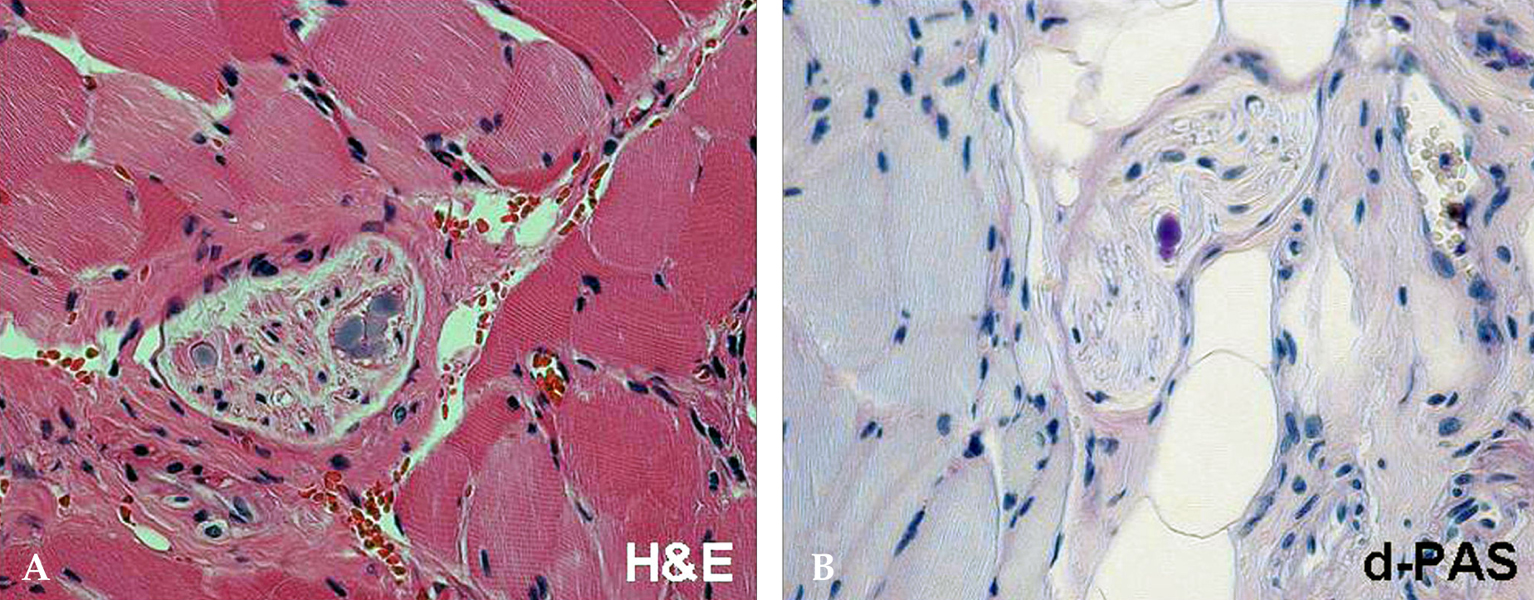Yonsei Med J.
2007 Aug;48(4):701-703. 10.3349/ymj.2007.48.4.701.
A Case of Adult Polyglucosan Body Disease
- Affiliations
-
- 1Department of Neurology, Yonsei University College of Medicine, Seoul, Korea. ycchoi@yuhs.ac
- 2Department of Neurology, Inje University College of Medicine, Sanggye Paik Hospital, Seoul, Korea.
- 3Department of Pathology, Yonsei University College of Medicine, Seoul, Korea.
- KMID: 2158178
- DOI: http://doi.org/10.3349/ymj.2007.48.4.701
Abstract
- Adult polyglucosan body disease (APBD) is a rare neurological disease, characterized by adult onset (fifth to seventh decades), progressive sensorimotor or pure motor peripheral neuropathy, upper motor neuron symptoms, neurogenic bladder, and cognitive impairment. APBD is confirmed by a sural nerve biopsy that shows the widespread presence of polyglucosan bodies in the nerve. We report a 70 year old male patient who exhibited progressive weakness in all extremities and dementia. His electrodiagnostic studies showed sensorimotor polyneuropathy and muscle pathology that consisted of polyglucosan bodies located in small peripheral nerves. This is the first case of APBD reported in Korea.
MeSH Terms
Figure
Reference
-
1. Klein CJ, Boes CJ, Chapin JE, Lynch CD, Campeau NG, Dyck PJ, et al. Adult polyglucosan body disease: case description of an expanding genetic and clinical syndrome. Muscle Nerve. 2004. 29:323–328.
Article2. Sindern E, Ziemssen F, Ziemssen T, Podskarbi T, Shin Y, Brasch F, et al. Adult polyglucosan body disease: a postmortem correlation study. Neurology. 2003. 61:263–265.
Article3. Milde P, Guccion JG, Kelly J, Locatelli E, Jones RV. Adult polyglucosan body disease. Arch Pathol Lab Med. 2001. 125:519–522.
Article4. Robertson NP, Wharton S, Anderson J, Scolding NJ. Adult polyglucosan body disease associated with an extrapyramidal syndrome. J Neurol Neurosurg Psychiatry. 1998. 65:788–790.
Article5. Trivedi JR, Wolfe GI, Nations SP, Burns DK, Bryan WW, Dewey RB. Adult polyglucosan body disease associated with lewy bodies and tremor. Arch Neurol. 2003. 60:764–766.
Article6. Klein CM, Bosch EP, Dyck PJ. Probable adult polyglucosan body disease. Mayo Clin Proc. 2000. 75:1327–1331.
Article7. Robitaille Y, Carpenter S, Karpati G, DiMauro SD. A distinct form of adult polyglucosan body disease with massive involvement of central and peripheral neuronal processes and astrocytes: a report of four cases and a review of the occurrence of polyglucosan bodies in other conditions such as Lafora's disease and normal ageing. Brain. 1980. 103:315–336.
Article



